










































April 2024 • Volume 13, No. 6
CEO Michael Shepard
VICE PRESIDENT OF CONTENT Leon Espinoza
EDITORIAL DIRECTOR Mike Teegarden, CCC
DEPUTY EDITORIAL DIRECTOR
Noble Sprayberry
SENIOR EDITOR Jennifer Paton, CCC
FLORIDA CURRENTS EDITORS
Chasity Anderson, CCC; Valeri Pearon
ASSISTANT EDITORS Victoria Hampton, CCC;
David Herder, CCC
ASSOCIATE EDITOR
Nina Todea
PUBLICATIONS PRODUCTION
SENIOR MANAGER
Elizabeth Beatty
PUBLICATIONS COORDINATOR
Alyssa McDougle
Members acknowledge that $4.31 a year, plus postage, is the cost to publish 12 issues a year of FLORIDA CURRENTS ISSN 23276304 (USPS 8300). Published by Pioneer Utility Resources Inc., 5625 NE Elam Young Pkwy. Ste. 100, Hillsboro, OR 97124—a not-for-profit Oregon cooperative corporation—the magazine serves the communication needs of consumerowned electric utilities in Florida. Preferred Periodicals postage paid at Hillsboro, OR 97123 and at additional mailing offices.
Postmaster: Send address changes to 5625 NE Elam Young Pkwy., Ste. 100, Hillsboro, OR 97124-6422.
HOW TO CONTACT FLORIDA CURRENTS
Subscription services:
Nonmember subscriptions $15 U.S. a year; $25 foreign a year. Prepayment required. Allow 4-8 weeks for first issue. Identify local edition desired. Have a problem receiving your magazine? Utility members should contact their utility office. Nonmembers call 503-357-2105 or email mailingdept@pioneer.coop.
Back issues:
Back issues and extra copies are $3 each, prepayment required. Supply is limited. Identify edition, month and year. Call first to check availability. Contact Pioneer Utility Resources: P.O. Box 1306, North Plains, OR 97133-1306; 503-357-2105; email: mailingdept@pioneer.coop.
DISPLAY ADVERTISING INQUIRIES
American MainStreet Publications 611 S. Congress Ave. Ste. 504 Austin, TX 78704-1714; 800-626-1181 or 512-441-5200; amp.coop.
© 2024 Pioneer Utility Resources. All rights reserved. Reproduction in whole or in part without written permission is prohibited. Direct reprint requests to editor@floridacurrents.com or for more information, visit www.pioneer.coop.


Is the contact information on your PRECO account up to date? If not, you could be missing important cooperative updates. Please provide updated information through your PRECO.coop online account, the SmartHub mobile app or by calling 800-282-3824.

PRECO.coop
Dear Members,
With the memory of Hurricane Ian behind us, 2023 started with getting back on track, managing exponential growth and working to thwart the impacts of inflation. Whether balancing the impacts of higher natural gas prices or securing unpredictable material supply, we remained vigilant in our mission to provide reliable electric service and excellent customer care at affordable rates.
The supply chain remains an important area of concern with our business. Though it has eased in some areas of the country, Florida has continued its steadfast increase in population. Many sectors are in fierce competition for the material we need to support this growth.
PO Box 1310
210 Metheny Road
Wauchula, Florida 33873
1.800.282.3824

In 2023, Peace River Electric Cooperative saw an annual account growth rate of 7.6%, as we surpassed 63,000 accounts served. That’s an average of more than 12 services a day added to our system—a total of 4,480 new accounts. PRECO remains ranked nationally as one of the fastest-growing cooperatives in the country by percentage growth in consumers. Sales were also up 10.2%, as we sold more than 1 billion kilowatt-hours for the second straight year.
SHAW General Manager/CEO
Extensive growth requires diligent forethought and planning, including multiple system projects. An additional distribution transformer was added to our existing S.R. 70 transmission substation site in Lakewood Ranch. Work is underway to complete the connection of the substation to our electric grid. Permitting and site work is planned for another new distribution substation near Parrish. Expansive voltage conversion work is underway, with voltage conversions slated for Hardee and Desoto counties.
Growth of this magnitude has direct financial effects on a cooperative. Fortunately for PRECO, streamlined and innovative operational efficiencies have allowed us to manage our rapid growth while keeping costs down and workforce levels steady. Last year had favorable conditions, resulting in affordable rates as members faced the weight of an inflated economic landscape. PRECO returned more than $2.5 million in capital credit retirements to our members. More than 9% of power cost savings were reflected in the average bill. We encourage you to review the financials in our annual report.
We remain committed to serving our communities’ school systems and community programs through our charitable foundation, Operation Round Up. ORU has awarded more than $1.2 million in scholarships since 2006—more than $100,000 this year. ORU meets needs in our community by supporting hurricane relief funds, food bank donations and teacher mini-grants. This program is funded by our members’ voluntary contributions of a desired amount or simply rounding their electric bills up to the next dollar each month.
As we look forward to 2024, our mission remains tried and true: work diligently to keep our rates affordable, focus on exemplary customer care and provide a safe, steady flow of reliable electric power. We appreciate and value the opportunity to serve you, our members, this year and for many years to come.

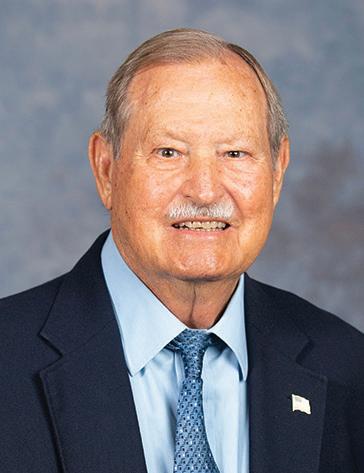



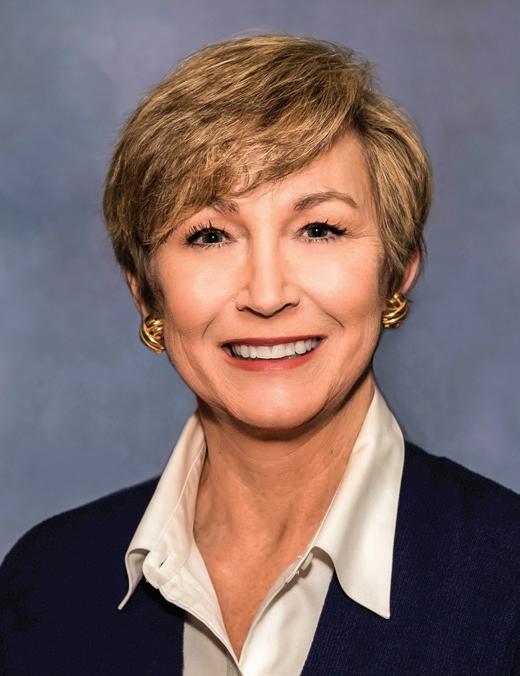

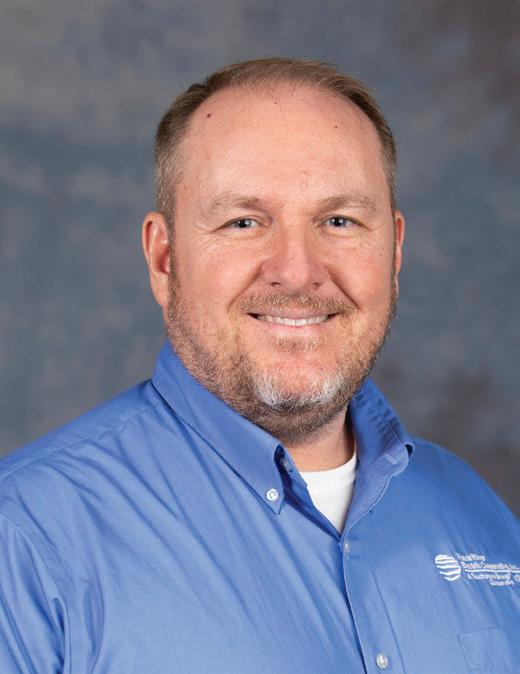

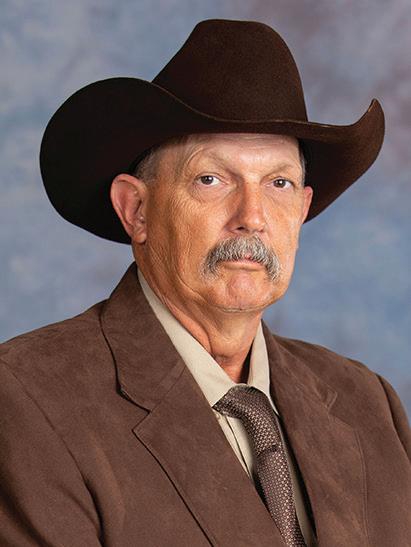
Among the responsibilities of the Peace River Electric Cooperative Board of Directors are overseeing legal requirements, revising bylaws and operating policies, approving major contracts and agreements, ensuring adherence to sound business practices, and maintaining an adequate and reliable power supply at the most reasonable cost to our members.
PRECO is a notfor-profit electric distribution cooperative with more than $135 million in annual revenue and more than $370 million in total assets, serving more than 63,000 active accounts in Brevard, DeSoto, Hardee, Highlands, Hillsborough, Indian River, Manatee, Osceola, Polk and Sarasota counties.


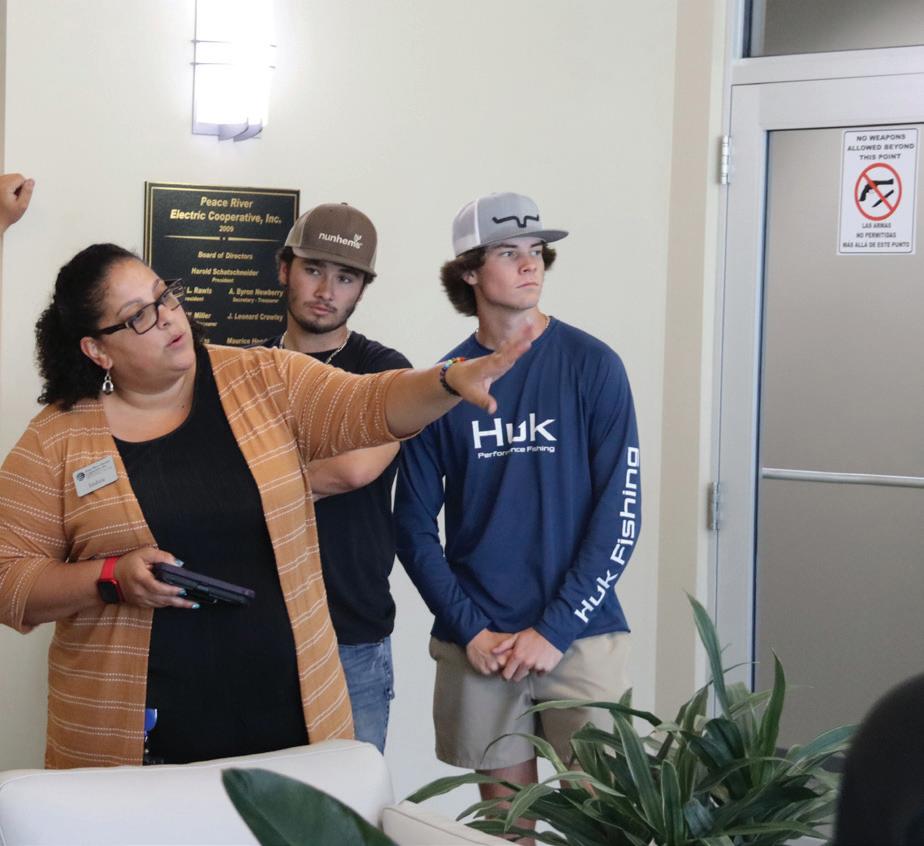




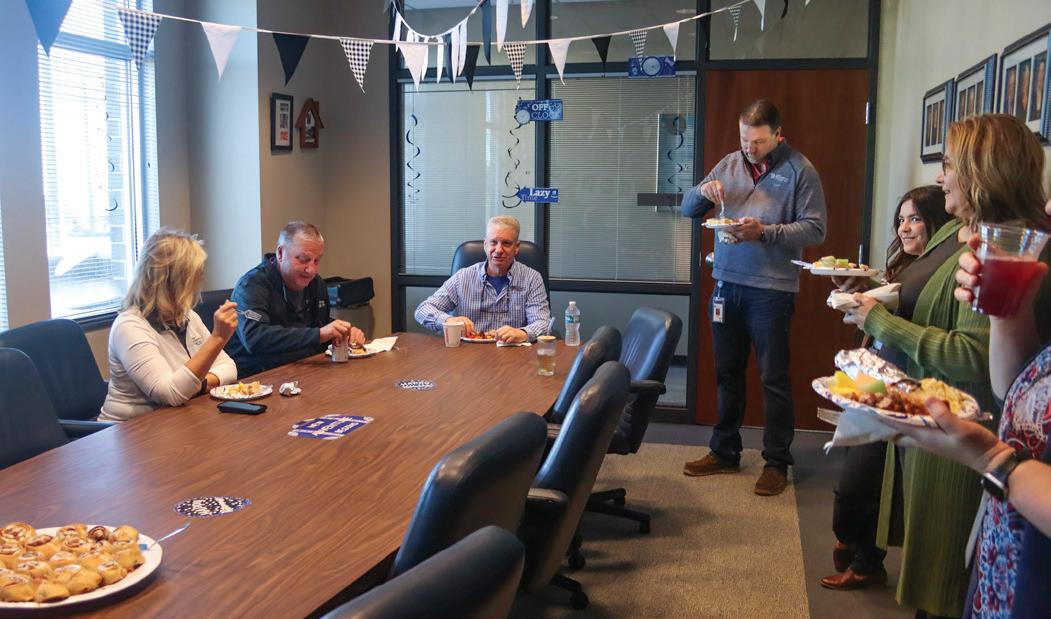

As an esteemed employee for the last 34 years, Mark Sellers has been the beacon guiding us through the dynamic landscape of Peace River Electric Cooperative. From the early days of working as an accountant clerk and payroll specialist to the present era of advanced connectivity, Mark has played a pivotal role in shaping our cooperative’s communications strategy.
Mark navigated the cooperative through various technological advancements with dedication and foresight, ensuring our members and employees stayed well-informed. The magazine editions, emails, website communications and social media posts bear the indelible mark of his commitment to transparent and effective communication.
Through decades of change, Mark has been a steady hand in times of uncertainty. Whether navigating through industry transformations, hurricanes, pandemics or fostering a sense
of community within the cooperative, Mark demonstrated professionalism and warmth.
One of Mark’s greatest strengths was his ability to adapt to the evolving needs of our cooperative. He embraced new technologies, always staying ahead of the curve to ensure our communications methods remained cutting edge.
As we bid farewell to Mark, we reflect on his immeasurable impact on our cooperative family. His legacy is not just in the words he crafted or the events he planned or took part in but in the enduring sense of unity and purpose he instilled within our organization.
As he steps into the well-deserved realm of retirement, we know that his light will continue to guide the cooperative. We hope his next chapter is filled with relaxation, joy and the warmth of a community that deeply appreciates the legacy he leaves behind. n

Full tang stainless steel blade with natural bone handle —now ONLY $79!
The very best hunting knives possess a perfect balance of form and function. They’re carefully constructed from fine materials, but also have that little something extra to connect the owner with nature.
If you’re on the hunt for a knife that combines impeccable craftsmanship with a sense of wonder, the $79 Huntsman Blade is the trophy you’re looking for.
The blade is full tang, meaning it doesn’t stop at the handle but extends to the length of the grip for the ultimate in strength. The blade is made from 420 surgical steel, famed for its sharpness and its resistance to corrosion.
The handle is made from genuine natural bone, and features decorative wood spacers and a hand-carved motif of two overlapping feathers— a reminder for you to respect and connect with the natural world.
This fusion of substance and style can garner a high price tag out in the marketplace. In fact, we found full tang, stainless steel blades with bone handles in excess of $2,000. Well, that won’t cut it around here. We have mastered the hunt for the best deal, and in turn pass the spoils on to our customers.
But we don’t stop there. While supplies last, we’ll include a pair of $99 8x21 power compact binoculars and a genuine leather sheath FREE when you purchase the Huntsman Blade
Your satisfaction is 100% guaranteed. Feel the knife in your hands, wear it on your hip, inspect the impeccable craftsmanship. If you don’t feel like we cut you a fair deal, send it back within 30 days for a complete refund of the item price.
Limited Reserves. A deal like this won’t last long. We have only 1120 Huntsman Blades for this ad only. Don’t let this beauty slip through your fingers. Call today!
Huntsman Blade $249* Offer Code Price Only $79 + S&P Save $170 1-800-333-2045
Stauer® 8x21 Compact Binoculars -a $99 valuewith purchase of Huntsman Blade


Call today and you’ll also receive this genuine leather sheath!

14101 Southcross Drive W., Ste 155, Dept. HBK225-01 Burnsville, Minnesota 55337 www.stauer.com

*Discount is only for customers who use the offer code versus the listed original Stauer.com price.
California residents please call 1-800-333-2045 regarding Proposition 65 regulations before purchasing this product.
Your Insider Offer Code: HBK225-01 You must use the insider offer code to get our special price. • 12” overall length; 6 ¹⁄2” stainless steel full tang blade • Genuine bone handle with brass hand guard & bolsters • Includes genuine leather sheath
Stauer… Afford the Extraordinary ®
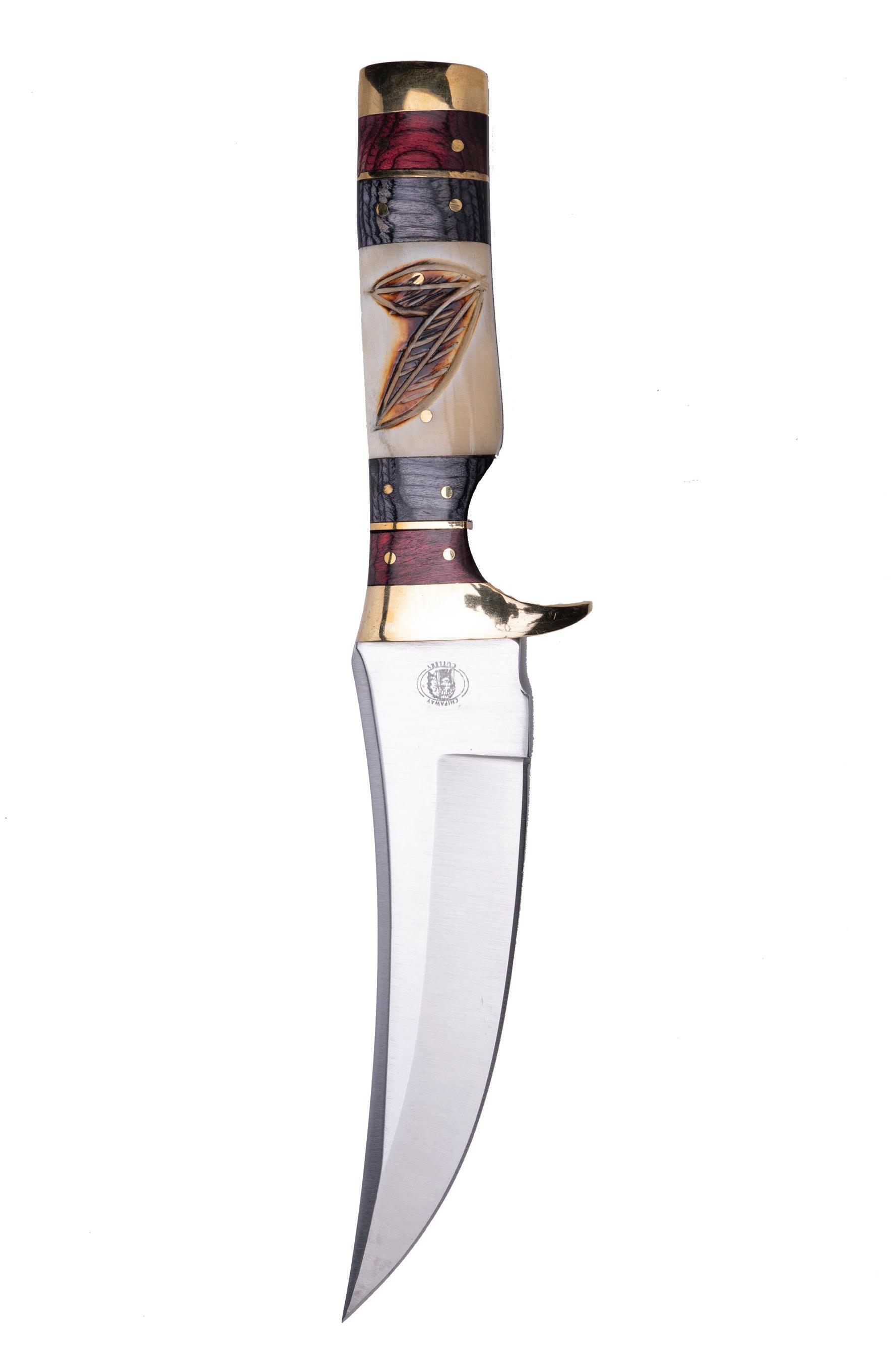
What Stauer Clients Are Saying About Our Knives
“This knife is beautiful!” — J., La Crescent, MN
“The feel of this knife is unbelievable...this is an incredibly fine instrument.” — H., Arvada, CO





eyes from damage.
By Pamela A. Keene
If you missed the North American solar eclipse in 2017, another chance to witness this astronomical wonder is just around the corner. On the afternoon of Monday, April 8, a total solar eclipse will cut a swath of twilight across the United States from South Texas northeast to Maine.
“If Floridians want to view the eclipse in totality, the nearest state is Texas, but don’t let that discourage you,” says Hannah Sparkes, planetarium assistant at Bishop Museum of Science and Nature in Bradenton. “Parts of Florida will experience as much as 40% to 60% occlusion—the shadow of the moon blocking this percentage of the sun. Even in South Florida, they will be able to see the effects with the proper safety measures.”
Safety First
Safety when viewing an eclipse is crucial, and there are several ways to protect your
“You must protect your vision if you plan on looking directly at the sun during an eclipse,” Hannah says. “Just a few seconds of its intense light—even when the sun is partially obscured—can result in serious damage to your retina.”
If you don’t have specially designed solar viewing glasses, you can make an eclipse viewer using a piece of paper with a small pinhole to project the changing shape of the sun as the moon passes in front of it.
“Actually, this works with anything that has small holes in it, like a colander, an


index card with a hole punched through it or even loosely overlapped fingers,” says Jose Cotayo, education specialist at the Museum of Science and Industry in Tampa. “Stand with your back facing away from the sun and remember you’re using the hole to project the image onto another surface, not as something to look through.”
Through solar viewing glasses, the eclipse will look like someone has taken a bite out of the sun as the moon’s shadow passes over it. The projected images, whether from a pinhole projector or other device, will be crescent-shaped.
There are two types of solar eclipses. A total eclipse results when the moon’s shadow completely covers the sun. An annular eclipse occurs when the moon’s shadow obscures all but the sun’s outer edge, making it look like a bright ring in the sky for a few moments.
“This upcoming solar eclipse is important for several reasons,” Jose says. “First, it is the second total solar eclipse to cross North America in the past seven years. Second, it will be seen by tens of millions of people. Third, for us in the contiguous United States, it will be the last total solar eclipse to cross our continent until August 12, 2045.”
The width of the path of totality of this year’s total eclipse will be wider than in



2017 because the moon is closer to Earth this time. It will take longer for the moon’s shadow to pass in front of the sun, and totality will last a bit longer.
The path of totality will cover three countries, starting in Mexico, traveling across Texas and continuing northeast through nearly a dozen states plus parts of several Canadian provinces.
In the weeks leading up to the April 8 event, Bishop Museum of Science and Nature has offered live planetarium shows





about the eclipse and updates to its social media at @BishopScienceFL.
Catch the Eclipse
The Museum of Science and Industry in Tampa will celebrate the eclipse with the following events April 8:
• Sun-safe telescopes. Experts will be available from 1:30 to 4 p.m.
• Livestreams from various locations across the country.
• Hands-on activities in the Ritual Observatory.
• Eclipse glasses will be on sale for $5, or you can bring your own.
• The event is included with museum admission.
For more information, visit Bishop Museum of Science and Nature in Bradenton at bishopscience.org and Museum of Science and Industry in Tampa at www.mosi.org. For general information, maps and specific eclipse information, visit greatamericaneclipse.com. To find the times for a specific city, go to eclipse2024.org/eclipse_cities.








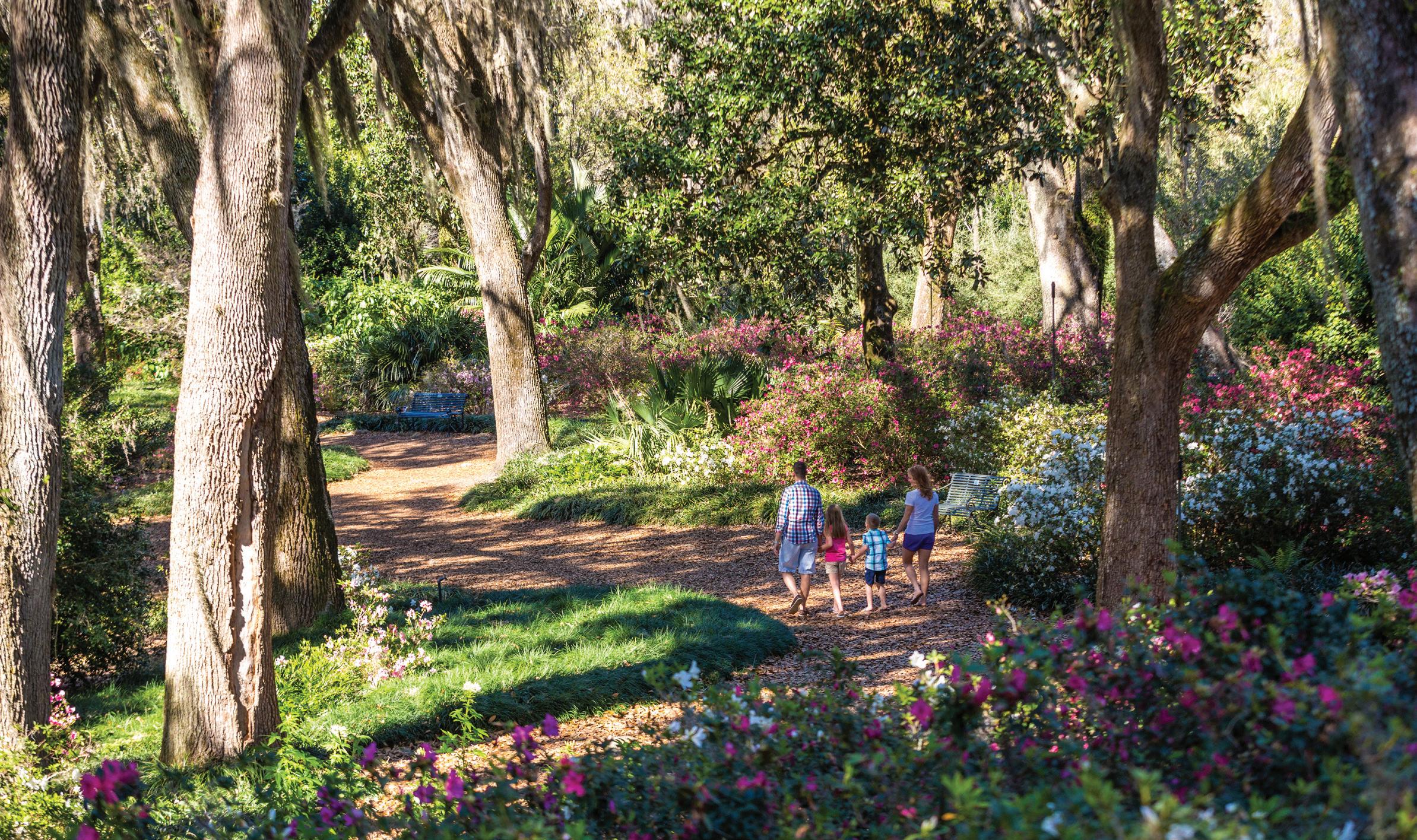
By Pamela A. Keene
Sixty bronze carillon bells collectively weighing more than 63 tons make beautiful music at Bok Tower Gardens in Lake Wales. Emanating from the 205-foot pink-and-gray marble bell tower at the gardens, twice-daily concerts feature classical compositions from the 17th through 21st centuries, as well as jazz, pop, country and other music genres.
“Bok Tower Gardens is a serene place of beauty, culture and history, but it is so much more than that,” says Erica Smith, director of marketing and public relations at Bok Tower Gardens. “From our acres of colorful gardens and our carillon tower to El Retiro retreat and Hammock Hollow Children’s Garden, visitors are finding more reasons than ever to visit.”
Several years ago, an area was set aside specifically for children. Fairy doors, whimsical musical instruments, winding paths, edible gardens and interactive activities pique the interest of youngsters yearning to explore nature hands-on.
“Hammock Hollow’s 3 acres include touch-and-feel activities, so children can experience the different textures of plants, and they can taste the plants in the edible section,” Erica says. “We also host programming—from planting to arts and crafts projects related to gardening—to help them learn where their food comes from.”
The River Walk section’s interactive water fountain area, where children can climb and play, mimics Florida’s geology. The Fairy House Trail opens a new world of fantasy, and the Frog Hop promotes being active. Sabal Stage encourages role-playing.
“In addition to giving children a place of their own, Hammock Hollow teaches them about nature and conservation,” Erica says. “The premise is discoverybased learning and an appreciation for natural beauty.”
A larger-than-life bird’s nest, complete with artistcreated sand jay eggs, welcomes children to enter. Near the Visitors Center, Hammock Hollow features an outdoor kitchen and a discovery center.
Known in the 1930s as El Retiro, the former winter home of Bethlehem Steel executive S. Austin Buck, is open for self-guided tours.
The gardens acquired the 20-room, 12,900-squarefoot retreat in the 1970s and restored the house and grounds, then known as Pinewood Estate. The name was changed back to El Retiro, the Spanish word for retreat.
“El Retiro is an excellent example of Mediterraneanstyle architecture with thick walls, a barrel-tile roof, carved doors, extensive woodwork and detailed wrought iron,” Erica says. “It’s a perfect complement to Bok Tower Gardens.”
Many of the furnishings in the home are original.
“A visit to El Retiro is truly a step back in time,” she says.
Nearly 100 years ago, Edward W. Bok conceived of a garden sanctuary to leave a legacy of thanks to his adopted country, the United States. He was a Pulitzer Prize-winning author, humanitarian and publisher of Ladies’ Home Journal after emigrating from the Netherlands at age 6.
Edward and his wife, Mary Louise Curtis, lived most of the year in Philadelphia, but the couple wintered in Central Florida’s Mountain Lake, about 10 miles from the site of today’s Bok Tower Gardens. In 1921, Edward climbed the tallest hill near his winter home, bought the land and commissioned famed New York City landscape architect Frederick Law Olmsted Jr. to create a wildlife sanctuary and garden. Work began in 1924.
“Olmsted designed the gardens to be both a retreat and an informal woodland setting with beautiful vistas, peaceful resting places and a constantly changing work of art by planting acres of ferns, palms, pines and oaks,” Erica says. “Against that lush backdrop, he brought in azaleas, camellias and magnolias for seasonal color.”
During the next several years, Edward enlisted other well-known architects, artisans and craftspeople to help refine his vision.
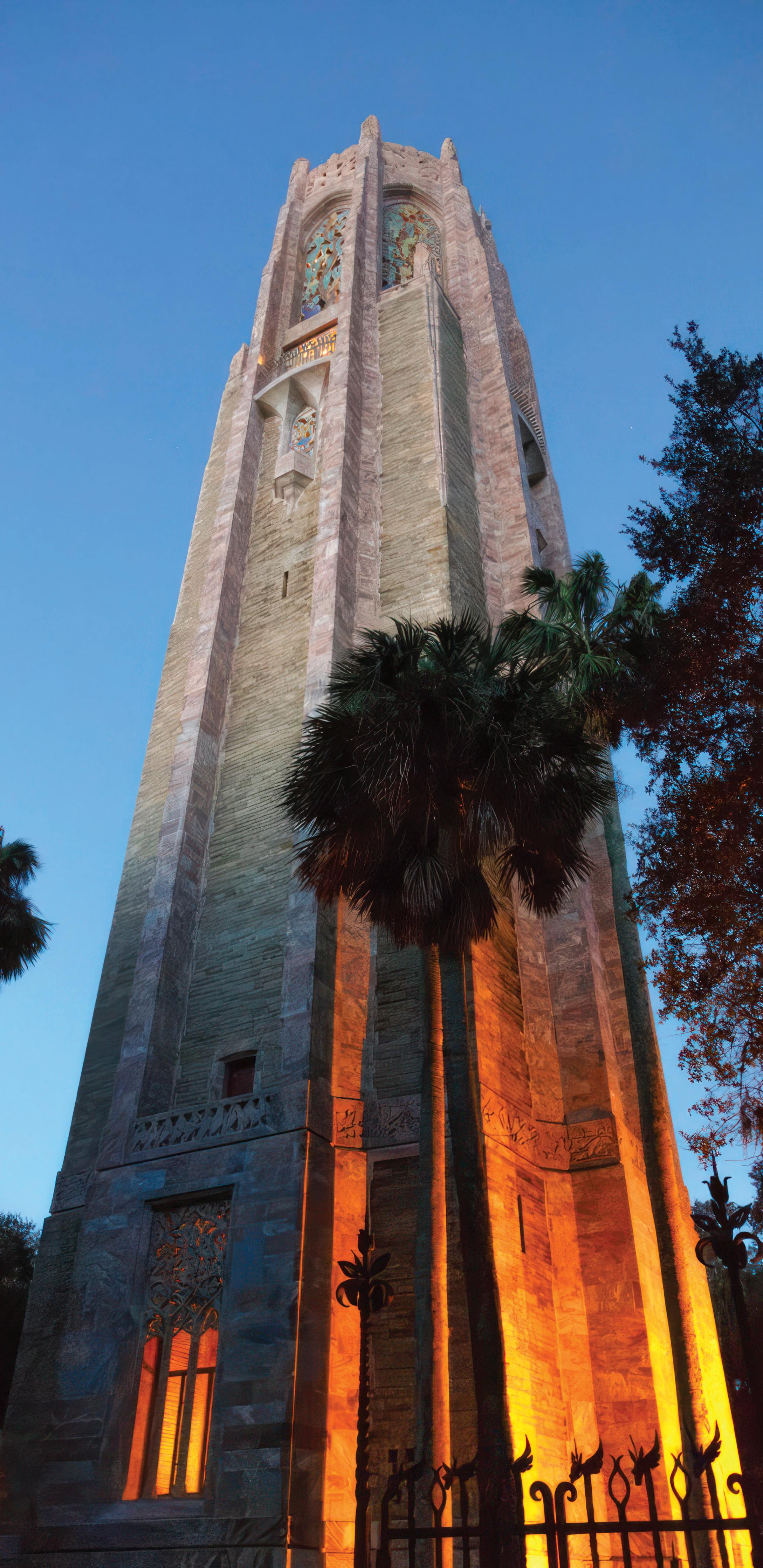

Perhaps the most important element of the gardens, the carillon tower, was added late in the process, with construction beginning in 1927 and completed in late 1928.
Philadelphia architect Milton B. Medary was commissioned to design the tower. His firm had designed the Justice Department building in Washington, D.C., and the Washington Memorial Chapel at Valley Forge.
“Bok’s project gave Medary the opportunity to blend Gothic architecture with elements that represented nature, including coquina stone from St. Augustine, pink-and-gray marble from Tate, Georgia, sculptures and a brass door designed by metalworker Samuel Yellin,” Erica says. “The tower became an incredible work of art created by some of the best craftspeople of the day.”
The tile grills covering the openings of the bell chamber were

ABOVE: Concerts under the stars also bring in crowds.
conceived by the founder of Enfield Pottery and Tileworks, J.H. Dulles Allen. He designed open panels showing native birds, animals, trees, turtles and human figures in shades of turquoise, cobalt and neutral colors.
Since the gardens opened, four carillonneurs have brought the Bok Tower carillon to life. Edward selected the first, and longest-serving musician, Belgium-born Anton Brees, to be the bell master beginning in 1929—first performing at the dedication on February 1, 1929. Anton served as carillonneur until his death in 1967.
“Brees performed around the globe and helped bring attention to Bok Tower Gardens and our fine carillon,” Erica says. “It has an excellent reputation around the world.”
In 2012, another Belgium-born carillonneur, Geert D’hollander, was chosen to carry on the tradition.

A Musical Heritage
The Bok carillon was the first in Florida. It’s also the tallest. Two others exist: the 61-bell, 157-foot-tall Century Tower at the University of Florida in Gainesville and the 97-bell, 200-foot Stephen Foster Memorial Carillon at the Stephen Foster Folk Culture Center State Park in White Springs.
“As the centerpiece of our 250-acre gardens, the carillon and its music contribute to our beauty, culture and heritage,” Erica says. “It’s hard to describe. For people visiting the first time, the sounds of the carillon and the beautiful surroundings are almost ethereal. Unless you’ve traveled overseas, you’re not very familiar with the carillon.”
She is quick to point out that a carillon is a musical instrument invented in the 16th century in what is now Belgium.
“Many people mistakenly believe that it’s a bell tower with chimes or that they can ascend its 205 feet for distant views of central Florida, but it is a fine musical instrument,” Erica says. “In fact, carillons are the largest musical instruments in the world.”
Carillons are played on a keyboard and with foot pedals. Twice daily, the carillon bells ring out in 30-minute concerts,

The first time carillonneur Geert D’hollander played the Bok Tower carillon was in 1980. He and his father, also a carillonneur, traveled from their native Belgium to Lake Wales to experience the renowned instrument. Geert was 17 years old at the time.
“As a child, I often accompanied my father, Joseph, to work as he played the carillons of historic European bell towers,” he says.
“When I turned 13, I decided I wanted to learn to play the carillon, so I enrolled in the Royal Carillon School in Mechlin, Belgium, where my father taught. I graduated at age 17, and my father flew me to Florida and Bok Tower that same year. He said he wanted me to experience the world’s most beautiful carillon.”
During that trip in the 1980s, both father and son performed on the world-famous 60-bell carillon before heading home.
Twenty-two years later, Geert returned to Winter Park, this time as Bok’s fourth carillonneur. He readily admits he’s glad that Bok Tower has an elevator.
“After 25 years of climbing steps in European bell towers, I was definitely ready for an elevator,” he says. “Playing the carillon—we play with our fists instead of our fingers—is very physical, but sometimes climbing the steps is harder than playing.”
performed from inside the bell tower. The bells also play on the hour and the half-hour.
Bok Tower Gardens Today
Edward’s vision of honoring his adopted country with a native garden, wildlife refuge and musical showplace has brought more than 23 million visitors from around the world to Central Florida.
It is in Lake Wales, on one of the highest points on the Florida peninsula, and features more than 200 acres of gardens and hiking trails. Combined with the height of the hill on which it sits, the top of the tower is 295 feet above sea level. It is listed on the National Register of Historic Places and is a designated site on the Great Florida Birding Trail.
Throughout the year, workshops include birdhouse-making, painting, edible landscaping and specialized guided botanical and garden tours.
Daily carillon concerts—typically featuring classical music—are at 1 p.m. and 3 p.m. n
For more information, visit boktowergardens.org or call 863-676-1408.



Nonstick cooking spray
4 6-inch corn tortillas
4 cups water
Salsa
1 medium avocado, diced
1 medium Anaheim or poblano pepper, seeds and ribs discarded, diced
1 medium tomatillo, papery husk discarded, washed and diced
½ medium tomato, diced

1 tablespoon white vinegar
4 large eggs
¼ cup diced red onion
¼ cup chopped fresh cilantro
2 tablespoons fresh lime juice
1 medium garlic clove, minced
1⁄8 teaspoon salt
Heat oven to 400 F. Line baking sheet with aluminum foil. Lightly spray foil with nonstick cooking spray. Arrange tortillas in a single layer on foil. Lightly spray tortillas with nonstick cooking spray. Using a fork, pierce tortillas to prevent them from filling with air. Bake for 5 to 6 minutes on each side or until golden brown. Transfer to serving plates.
In a large skillet over high heat, bring water and vinegar to a boil.
Once water is boiling, reduce heat and simmer. Break egg into a cup, then carefully slip egg into simmering water. Repeat with remaining eggs, avoiding eggs touching in water. Simmer for 3 to 5 minutes, or until egg whites are completely set and yolks are beginning to set but aren’t hard. Using a slotted spoon, remove the eggs to a plate.
To make the salsa: In a medium bowl, gently stir together avocado, pepper, tomatillo, tomato, red onion, cilantro, lime juice, garlic and salt. Spoon onto the tostadas, then top each tostada with an egg. Recipe and photo source: American Heart Association
1 pound potatoes, peeled and diced or shredded
2 tablespoons extra-virgin olive oil
½ cup diced red onion
2 cloves garlic, minced
4 large whole eggs, lightly beaten
2 egg whites, lightly beaten
2 tablespoons finely chopped fresh parsley
2 tablespoons finely chopped fresh basil
2 tablespoons finely chopped fresh chives
Salt, to taste
Fresh parsley sprigs, for garnish
Place potatoes in a large pan. Cover with water. Bring to a boil and cook, uncovered, for 3 minutes. Remove from heat. Cover. Let stand for about 10 minutes or until potatoes are tender. Drain well.
Heat oil in a deep, 10-inch nonstick skillet over medium heat. Add onion and garlic. Cook for about 8 minutes, stirring occasionally. Add potatoes and cook for 5 minutes. Combine whole eggs and egg whites. Stir in parsley, basil and chives. Season with salt, to taste. Pour mixture over potatoes in the hot skillet. Reduce heat and cook, uncovered, for about 10 minutes or until the bottom of the omelet is golden.
If desired, brown the top under a broiler. Garnish with fresh parsley sprigs.
Source: culinary.net
2 teaspoons canola oil
1 small red onion, diced
1 red bell pepper, seeded and diced
1 can black beans, drained and rinsed
¼ teaspoon red pepper flakes
Salt, to taste
Pepper, to taste
4 eggs
4 egg whites
½ cup shredded pepper jack cheese
Nonstick cooking spray
4 flour tortillas
¼ cup sour cream
¼ cup salsa
1 large tomato, seeded and diced
1 avocado, sliced
Hot sauce
In a large skillet, heat canola oil over medium heat. Add red onion and red bell pepper. Cook for 8 minutes. Add black beans and red pepper flakes. Cook for 3 minutes. Season with salt and pepper, to taste. Transfer to dish. In a medium bowl, whisk eggs and egg whites. Stir in cheese until combined. Heat a large skillet over low heat. Add egg mixture and scramble for 3 minutes or until cooked through.
Spread sour cream over the tortilla. Spread salsa over sour cream. Spoon ¼ bean mixture over salsa. Spoon ¼ scrambled eggs over the bean mixture. Top with diced tomatoes and avocado. Drizzle with hot sauce, if desired. Roll up burrito. Repeat three times with the remaining ingredients.
Source: culinary.net
Poblano Frittata
4 large eggs
¼ cup fat-free milk
2 tablespoons chopped fresh cilantro
1 teaspoon olive oil
2 medium poblano peppers, seeds and ribs discarded, chopped
2 cups frozen corn, thawed
2 medium green onions, chopped
¼ cup finely shredded cotija cheese or crumbled queso fresco
1 medium tomato, chopped
¼ cup fat-free sour cream
In a medium bowl, whisk eggs, milk and cilantro. Heat oil in a medium skillet over medium heat, swirling to coat the bottom of the skillet. Cook poblano peppers for 3 minutes or until browning on edges, stirring frequently. Stir in corn and green onion. Reduce heat to mediumlow. Carefully pour in egg mixture. Cook, covered, for 10 minutes, or until the mixture is just set on the edges and still soft in the center. Avoid overcooking. Remove from heat. Sprinkle with cheese. Cut into eight wedges. Top with tomatoes and sour cream.
Source: American Heart Association
2 teaspoons canola oil
½ medium onion, chopped
4 medium sweet potatoes, peeled and cut into ½-inch cubes
½ medium red or green bell pepper, chopped
2⁄3 cup fat-free, low-sodium vegetable broth
2 teaspoons minced garlic
2 teaspoons smoked paprika
1 teaspoon ground cumin
½ teaspoon dried thyme, crumbled
½ teaspoon coarsely ground pepper
1⁄8 teaspoon salt
4 large eggs
Hot pepper sauce
Heat oil in an electric pressure cooker set on saute. Cook onion for 3 minutes or until soft, stirring frequently. Turn off the pressure cooker.
Stir in potatoes, bell pepper, broth, garlic, paprika, cumin, thyme, pepper and salt. Secure lid. Cook on high pressure for 3 minutes. Quickly release pressure. Turn off the pressure cooker.
Remove the pressure cooker lid. Crack one egg into a small bowl. Using the back of a spoon, make a small well in potatoes. Slip the egg into the well. Repeat with the remaining eggs, making separate wells for each egg. Secure the lid with the pressure vent open. Saute for 2 minutes. Let stand on the keep-warm setting for 2 minutes or until eggs are cooked to desired consistency.
Serve hash sprinkled with a dash of hot pepper sauce.
Source: American Heart Association

By Dave LaBelle
They scrub and vacuum our floors, clean our desks and windows and toilets. But we don’t really see them, even when we watch them working.
These are the invisible heros.
I recently learned that 87-year-old Shirley Vorwald was still washing dishes and cleaning at a nearby elementary school, as she had also done

Renowned author, photographer and lecturer Dave LaBelle has captured special moments for more than half a century. For more of his writings, visit davidlabelle.com and bridgesandangels.wordpress.com.
the past 48 years.
When I asked about Shirley from those who knew her well, all agreed she was a tireless worker and charitable giver. But they warned she would never let me do a story on her because “she is an introvert and is not likely to talk with you.”
They were wrong, at least about talking to me.
Shirley was cordial and talkative, and even invited me into her small home, showing me every detail—living room, bathroom, bedroom, kitchen, even the smaller-than-standard oven in which she bakes hundreds of pies each year. Besides holding down at least two jobs most of her life, she loves to bake pies for people.
In fact, some only know her as the pie lady.
Never married, she says with no bitterness, “My dad didn’t believe in marriage. He didn’t want to lose his help on the farm.”
Shirley is the last of nine children. Her brother, Jerry, died recently at age 92. The day before Christmas, she baked him a birthday cake he never got to eat.
“He was in bed. He could see it but he couldn’t eat it,” she shares.
She is content. Working has been and is her life since growing up on a farm. At a time in life when most count the days to retirement, Shirley just wants to keep working. n

LEFT: NIKON D800, 50mm lens ISO 2000, f/9 at 1/60
ABOVE: NIKON D800, 31mm lens ISO 2000, f/3.5 at 1/250
Find an unseen hero in your community and shine a light on them. Explain to them that you see and appreciate them for what they do. You might have to persuade them since these invisible people can be shy. Honest, caring persistence can crumble those walls of distrust. Ask if you can interview them and do a portrait or even a short story about them. It is often easier to get shy people to talk than agree to be photographed, so talk first before asking about pictures.
Email your best image (just one, please) with caption information, including an explanation of how it affects you, to GPH@pur.coop. We may share submissions on our website and social media channels.



You read that right. If you’d like the Stauer genuine 26" cultured pearl necklace for FREE*, all you need to do is call us today. There is no catch. This stunning, romantic necklace never goes out of style. In a world where some cultured pearl necklaces can cost thousands, we’re offering ours for FREE*.
Stauer has had a very good year and it’s time for us to give back. That’s why we’re offering this stunning, 26" strand of genuine cultured white pearls for FREE! You pay only $24.95 for shipping & processing, our normal fee for a $295 necklace ... and we’ll even pay you back with a $30 Discount Certificate –– that’s our BETTER THAN FREE Shipping!


Why would we do this? Because we are so sure that you will become a loyal Stauer client in the years to come. Recently, we encountered a magnificent cache of cultured freshwater pearls at the best price that I have ever seen. Our pearl dealer was stuck. A large foreign luxury department store cancelled a massive order at the last minute. In their stead we grabbed all of those gorgeous pearls. He sold us an enormous cache of his roundest, whitest, most iridescent cultured 6 ½-7 ½ mm pearls for pennies on the dollar. His loss is your gain.

Too good to pass up. Too good to last long. Genuine cultured freshwater pearls are a luxurious statement. Stauer finds a deal this outrageous once every few years. We have sold over 200,000 strands of pearls in the last several years and this is our finest value ever. There is only a limited quantity left in stock, so when they’re gone, they’re GONE! Call to reserve your FREE Cultured Pearl Necklace today and experience a brilliant new definition of price-less luxury!
Mitsuko® Cultured Pearl Necklace:
Mitsuko® Cultured Pearl Necklace (26” strand) $295** FREE*
*Pay only shipping & processing of $24.95. Special price only for customers using the offer code.



“I couldn’t believe it, but decided to call and I’ve not been disappointed since. I received the necklace and keep coming back for more.”
— Amy, Fairmont, WV
















One
For many hunters, spring means turkey season. Some hunters strive to achieve a turkey grand slam by bagging at least one of the four wild turkey subspecies living in the United States: eastern, Rio Grande, Merriam’s and Osceola.
To achieve a grand slam, hunters must visit Florida. Two subspecies live in the Sunshine State: eastern and Osceola. The Osceola turkey is named after the Seminole war chief.
Eastern wild turkeys are found anywhere from the Great Lakes to the Gulf of Mexico and from New England to Eastern Texas, including all of the Florida Panhandle. However, Osceola turkeys only live in the Florida Peninsula and nowhere else in the world.
“Any wild turkey harvested within or south of the counties of Alachua, Bradford, Clay, Dixie, Duval, Gilchrist and Union would be an Osceola subspecies,” says Juliana Ofalt, the Florida Fish and Wildlife Conservation Commission Wild Turkey and Furbearer Management Program coordinator. “North of the peninsula and across the panhandle, Osceola wild turkeys interbreed with the eastern subspecies.”
Both subspecies look similar, with only subtle differences in appearance. Generally, location determines an eastern from an Osceola.
“An Osceola wild turkey is best distinguished from the eastern subspecies, which it closely resembles, by the white barring on its wing feathers,” Juliana says. “On Osceola wild turkeys, the white bars on the primary wing feathers are narrower than the black bars and are irregular or broken, which tends to give the wing an overall darker appearance compared to eastern wild turkeys. Osceola wild turkeys tend to be smaller-bodied than most eastern wild turkeys,


left, and
call
and are often found to have longer legs and spurs.”
Both subspecies love forests. They can live in swamps, hardwood bottomlands or pine forests, and they like edges, fields and openings. Wild turkeys regularly roost in oak, cypress or other trees along waterways to keep safe from predators, such as bobcats. In southern Florida, turkeys may encounter Florida panthers.
During the 2023 spring turkey season, hunters bagged 11,382 birds of both subspecies. People hunt thousands of acres on public lands throughout Florida, but for Osceolas they stay south.
“The top 10 wildlife management areas in the Osceola range with the highest number of reported harvested birds during the 2023 spring turkey season included Three Lakes, Kissimmee Chain of Lakes Area and Richloam,” Juliana says. “The top 10 WMAs with the least number of hunter days per turkey harvested during the 2023 spring season included Guana River, Spirit of the Wild and Okaloacoochee Slough.”
The FWC, in cooperation with the Northwest Florida Water Management District, offers hunting opportunities at a new Water Management Area, Garcon Point, which will include spring turkey opportunities during the 2024 season.
Regulations might differ from private lands and public lands. Therefore, before hunting anywhere, check the regulations for that area.
For turkey hunting zones, season dates and other regulations, visit myfwc.com/hunting/season-dates.

John N. Felsher is a freelance writer, broadcaster, photographer and editor. An avid sportsman, he’s written more than 3,500 articles for more than 170 different magazines on a wide variety of outdoor topics. He also hosts an outdoor tips show for WAVH-FM Talk 106.5 in Mobile, Alabama. Contact him at j.felsher@hotmail.com or through Facebook.












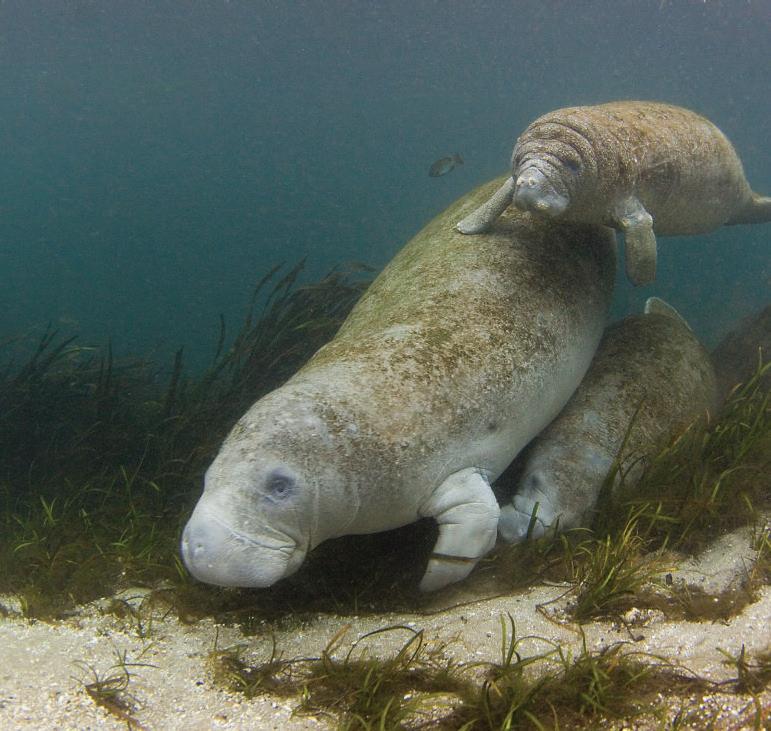





All ages can find something new and exciting around every corner of the state. Filled with rich history, abundant natural beauty and diverse events all year, Florida has something fun for everyone.
March 31
Easter Bunny Boat Parade
Join the boat parade or cheer from the shoreline of Lake Josephine. Line up at 4 p.m. at the opening of Josephine Creek. This event has been spreading joy and celebrating Easter for more than 20 years. www.twstages.com; 863-991-5545
April 2
Dinosaur World, Live!

April 6
Tour de Fort: Fort Pickens

Dare to experience the dangers and delights of Dinosaur World Live in this roarsome interactive show for all the family. Discover a prehistoric world of remarkably lifelike dinosaurs. A special meet-and-greet after the show offers all brave explorers the chance to make a new dinosaur friend.
www.twstages.com; 305-295-7676

April 19-21
Ladies, Let’s Go Fishing
Ladies, join in on the fun with this offshore fishing event. The weekend kicks off with a meetand-greet on Friday, followed by a full-day offshore seminar with hands-on practice on Saturday and optional fishing from charter boats on Sunday. Participants must register in advance online. www.ladiesletsgofishing.com; 954-475-9068
Join the Florida Public Archaeology Network and the National Park Service as we pedal, hike and climb our way through the archaeology of Gulf Islands National Seashore in celebration of Florida Archaeology Month. In addition to providing habitat for wildlife, the park protects some of Pensacola’s most important archaeological sites—on land and under water. Participants meet at the Fort Pickens Visitor Center auditorium at 10 a.m. www.visitpensacola.com; 850-934-2600
April 6
Annual Soda Festival
Soda lovers unite at this festival, where the world of bubbles comes alive. In addition to more than 200 craft sodas to sample, attendees can enjoy a day filled with food trucks, live music and family fun in downtown Sebring. www.sebringsodafest.com; 863-385-8448






April 6
41st Annual Pensacola Jazzfest
This free festival spans two days at Seville Square and is presented by Jazz Pensacola. The festival includes school bands, regional acts and national headliners. Food, arts and crafts, and jazz merchandise are available. www.pensacolajazzfest.com; 850-433-8382
April 6
Coon Hill Day 5K and Half Mile
The Coon Hill Cemetery trustees host this annual 5K and half-mile race to benefit the restoration and preservation of this historical landmark. The race course consists of an out-and-back course on dirt roads. T-shirts, drinks, fruit and cookies are provided. Entry fee is $20 during pre-registration and $25 on race day. www.active.com; 850-217-2603

April 18
MoradaWay Art Walk
Join us 6 to 9 p.m. for our monthly art walk and the Morada Way Arts and Cultural District’s landmark event. Keys-inspired fine artists, vendors, residents and visitors congregate on Morada Way to celebrate art and culture. This event includes gallery openings, local artists, live music and food. www.moradaway.org; 305-664-2471
April 20
Swim Across America
The third annual Florida Keys open water charity swim is 9 a.m. to noon at Founders Park. There is a kid splash and half-mile, 1-mile and 2-mile swims. All proceeds stay local, supporting Miami Cancer Institute. swimacrossamerica.org/floridakeys; 980-292-0179
April 20
Stock Island Earth Day Cleanup
Joins us 8 a.m. to noon in Bernstein Park for a community cleanup in honor of Earth Day. Cleanup is all morning, so feel free to stop by when you can. Participants are provided with vests, pokers and buckets. coastalove.org/stockisland


April 21
Earth Day Pensacola
Save the date for this festival from 10 a.m. to 4 p.m. at Bayview Park. The event showcases sustainable living through a fun day of environmental education, art, live music, local food, green products and hands-on activities. earthdaypensacola.com; 850-687-9968


April 26-27
Jay Pro Rodeo
In its 22nd year of giving back to the community, the rodeo’s proceeds benefit the Santa Rosa Kids House, Ronald McDonald House, My Father’s Arrows, high school sporting events and other areas of the community. The event starts at 8 p.m. at the Ted May Arena. Tickets are $10 for those 12 and older, $5 for 4- to 11-year-olds, and free for those 3 and younger. www.facebook.com/SandySansingJayPro
April 27
Pops in the Park
The Florida Keys Community Concert Band invites you to attend this free band concert at ICE Amphitheater in Founders Park. April’s event is Sci-Fi Serenade. Pack a picnic basket and blanket or chairs, and load up the family and furry friends for this night of music. keyscommunityconcertband.org; 305-294-1123


Want to share a family-friendly event with the readers of Florida Currents? Enter the details at tinyurl.com/ FloridaCurrents. Make sure to submit the item at least 60 days before the event (due to press deadline). If you own rights to a print-quality photo promoting your event, include it with photo credit information.

It’s easy to find ideas when designing your landscape, but it’s also important to be aware of what not to do.
Below is a list of the top 10 landscaping mistakes seen throughout the state. Don’t worry if you’ve made any of these mistakes; you have the tools to fix them.
Putting the Wrong Plant in the Wrong Place
If only landscaping was as easy as putting a plant where it looks nice. Instead, the light, moisture and soil conditions of the planting location need to match the plant’s needs.
For example, hydrangeas enjoy shade and soil that is rich and well drained. If the desired planting location is full sun, high in clay and tends to stay wet, your hydrangea will quickly deteriorate.
Failing to Prepare the Site Before Planting
This is especially problematic when installing landscaping at a newly constructed site.
Construction soil around the foundation of newly built houses may contain concrete, paint, adhesives and grout. This type of soil needs to be prepared or amended before planting.
The site also needs to be graded for proper drainage. Grade the slope away from the house and direct the water into swales or redirect water with in-ground drain pipes.
Planting Without Considering the Plant’s Mature Size
This mistake goes hand in hand with “wrong plant, wrong place.”
The plant you pick from the nursery may be the right size at the time, but it likely won’t stay that way. Make sure you research the max height and width for each plant you are considering and allow space for it to grow.
We often see plants that have been excessively pruned to keep a certain shape or size. Not only does this make maintenance more difficult, but this practice can also be detrimental to plant health.
Unknowingly Planting Invasives
Unfortunately, not all nurseries are responsible about keeping invasive plants off their shelves. You can check the invasive status for each plant you find by looking it up in “UF/IFAS Assessment of Non-Native Plants in Florida’s Natural Areas.” You can also shop at native nurseries to avoid this issue entirely.
Lack of Theme
A successful landscape design has a consistent theme. Without unification, the landscape can look messy and disorganized. Your theme can be as simple as choosing to follow a general shape or form, or as complex as building a Mediterranean garden.
The Ask IFAS publication “Landscape Design: Finding Inspiration for a Design Theme” has more information.




A higher water bill can dampen the excitement of a newly installed landscape. Choosing drought-tolerant plants can lower the amount of water required.
Other inputs should be considered as well. Does this plant likely require fertilization or pest protection? Selecting low-maintenance plants that require few to no inputs lessens the amount of time you spend working in the garden and cut costs.
Choosing the Wrong Groundcover
Turfgrass is thought of as the default groundcover, but it isn’t ideal for every situation. For instance, it is not recommended for shady spots, on steep slopes or in small areas that are difficult to maintain. Use an alternate groundcover in these situations.
It can be tempting to plant right up to the foundation of your house, but this is not the best practice.
This doesn’t allow enough room for the plant to grow, which leads to the mistake of excessive pruning. It also makes maintaining your home more difficult. Pest problems are also exacerbated because of reduced airflow. Plant shrubs beyond the roof drip line.
Aesthetically pleasing doesn’t always equate to low maintenance. For example, trendy curved pathways give a playful feel to the landscape, but they are difficult to mow around.
You should be creative with your landscape design, but don’t forget about maintenance.
Replacing Groundcovers With Rock or Artificial Turf
For those who want a low-maintenance landscape, replacing groundcovers with rock or artificial turf seems like a great idea. However, these replacements don’t support wildlife and significantly increase heat in your yard.
Many HOA landscape codes also don’t allow gravel or artificial turf. Instead, choose groundcovers that don’t require much maintenance. Many groundcovers also support pollinators and improve the soil, unlike rock or artificial turf.

Natasha Atlas graduated from the University of Florida’s Agricultural Education and Communication Program in 2021. She loves writing about unique and new varieties of flowers and plants for the Neighborhood Gardener Newsletter and its 10,000 subscribers. When she isn’t writing, she enjoys tending her own garden on her balcony.
Working at the top of utility poles presents unique challenges and risks. A well-executed pole-top rescue during an emergency can mean the difference between life and death.
Peace River Electric Cooperative’s Wauchula Operations Center conducted its annual pole-top rescue demonstration training January 18. It was part of the yearly safety kick-off that includes training and qualifications.
Approximately 40 apprentices, lineworkers and supervisors participated in the event, focusing on equipping personnel with the skills and knowledge to respond effectively and efficiently if an incident occurs.
The pole-top rescue simulation has four basic steps:
• Analyze the situation.
• Use protective equipment.
• Determine the condition of the victim.
• Lower the victim.
Each participant in the activity was able to execute a successful rescue. Top times for the pole-top rescue were Seth McGee, 36 seconds; Josh Watson, 54 seconds; Logan Hill, one minute and 26 seconds; and Casey Vrabel, one minute and 46 seconds.
Pole-top rescue training is an indispensable aspect of ensuring the safety of our heroes who work with electricity every day.

On April 18, we celebrate the amazing Peace River Electric Cooperative lineworkers who power our lives. Help us thank our lineworkers for their hard work and commitment to keep the lights on. #thankalineworker

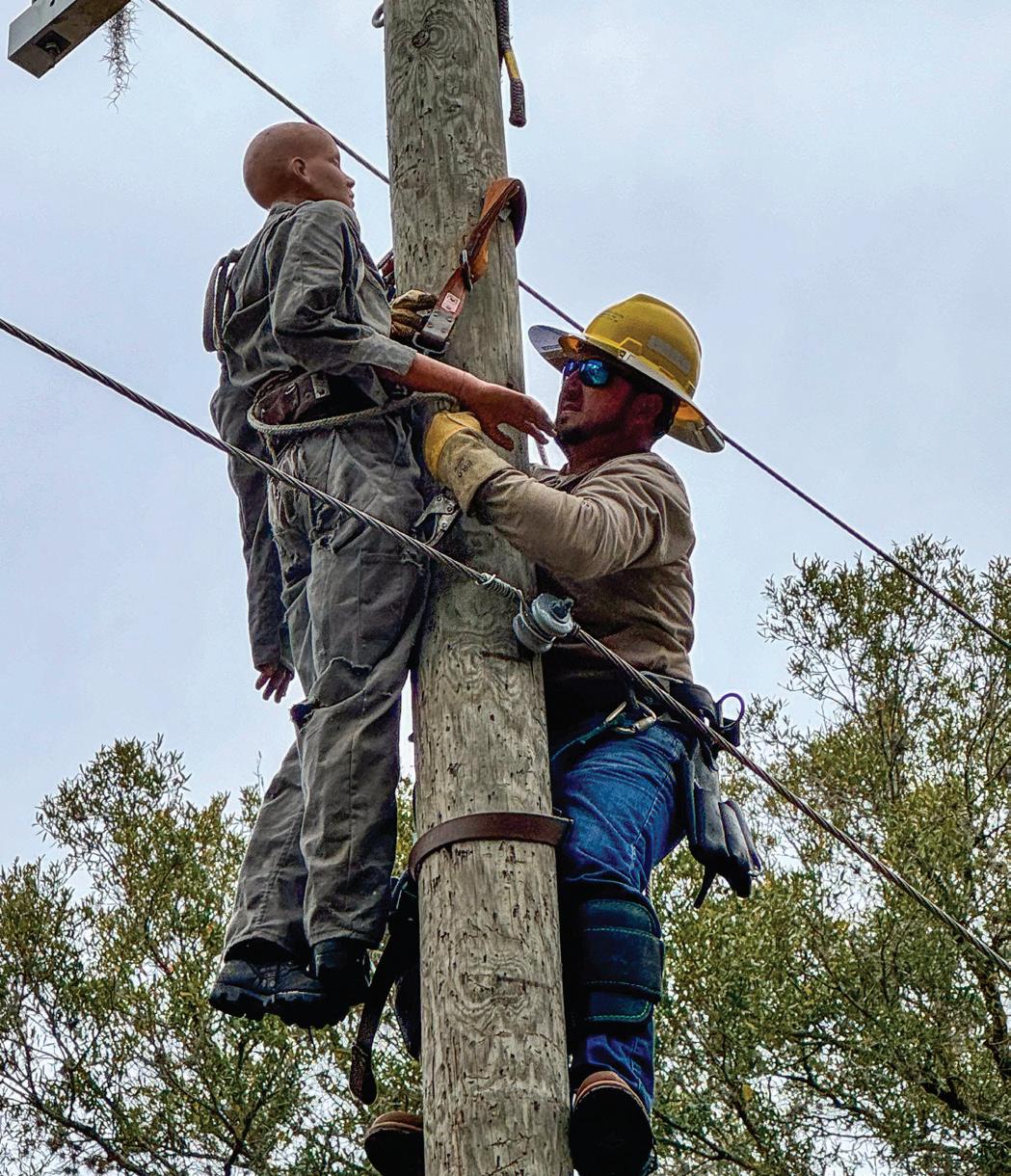













Showcase your talent behind the lens: Everyone is welcome to participate, whether you are a seasoned pro or just starting out.
An independent judge will select a maximum of six winning photos.
The Best of Show winner earns a $100 electric bill credit.
Other winning entries receive $50 electric bill credits.




The contest is open to PRECO members and their families. Employees are not eligible.
There is a maximum of three entries per person.
Photos must be vertical/portrait. Horizontal images are disqualified.
There are no categories. Submit your best shots.
Photos must be taken in PRECO’s 10-county service area: Brevard, DeSoto, Hardee, Highlands, Hillsborough, Indian River, Manatee, Osceola, Polk or Sarasota.
Photos must be your original work.
Photos must be high resolution, JPEG format, 300 ppi at 8-by-10 inches (minimum 1 MB file size).
Make photos around sunset or sunrise. The low light makes for prettier landscapes.










Some of last year’s winners include, from top, Bluebird Bug Breakfast submitted by Jeff Faulkner, Eagle Landing Zone by Gordon Silver and Gallinule Chick Sunrise by Jeff Faulkner.
Include people doing interesting things, such as kayaking, hunting, fishing or biking.
Get close to your subject(s), and fill the frame.




The Modern Solution
A Stiltz Homelift is a safe, attractive, & affordable alternative to stairlifts. It requires no special machine room, and no supporting walls.
Economical & Flexible
A Stiltz Homelift can t just about anywhere in your house. It has a compact footprint, similar in size to a small armchair. A Stiltz Homelift plugs into a standard home electrical outlet, using less power than boiling a kettle.
Your Forever Home
Avoid the expense and distress of relocating, or the disruption of adapting your home for downstairs living. A Stiltz Homelift helps you live safely and independently in the home you love.
Some Stiltz customers need a Homelift immediately. But others want to “future-proof” their homes for when the stairs become a challenge.
Homelift Specialists
Stiltz is a world leading Homelift manufacturer, so you’ll be in good hands. Your elevator will be installed and maintained by Stiltz trained professionals - who truly care about your freedom.
“I can’t imagine what we’d do without it. I wish we had installed our Stiltz Homelift several years ago!”
– Mr. James, Roanoke VA








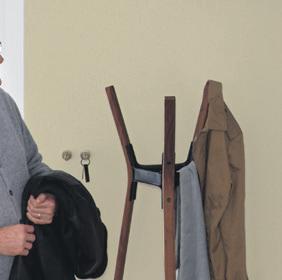














Anticipation mounted as Claire Thomas, communications coordinator of Peace River Electric Cooperative, entered the classroom of Tylar Alden, a teacher at Hardee Senior High School. The students were anxious to hear who had been chosen for the once-in-a-lifetime trip to Washington, D.C.
Jennifer Gonzalez-Delacruz and Gracyn Thomas won the opportunity to attend the 2024 National Rural Electric Cooperative Association Youth Tour trip. Each year, Peace River Electric Cooperative selects two students to represent the cooperative on a weeklong, all-expenses-paid trip to the nation’s capital during the summer.
To be considered, students must apply, write an essay describing why they would be a good representative for the co-op, submit a letter of recommendation from a teacher and participate in an on-site interview. During the interview, Jennifer and Gracyn both expressed immense appreciation for their teacher. They hope this trip will allow them to see their history book pages come alive as they embark on a weeklong excursion filled with many firsts.
During their stay in D.C., the students will visit historical
monuments, Arlington National Cemetery, the Holocaust Museum and more. Following a visit to the U.S. Capitol, they will speak with U.S. representatives from Florida and other elected officials.





Each summer, Youth Tour brings roughly 1,800 students from electric cooperatives from across the country to visit the sites of Washington, D.C. The National Rural Electric Cooperative Association, headquartered in Arlington, Virginia, has coordinated this event annually for 67 years.
“After the trip, students come back with a much better understanding and appreciation for U.S. history and the role that legislators and officials play in our government,” Claire says. “Over the years, some delegates have credited Youth Tour with influencing them to seek a career path as a congregational aide or politician.”
To learn more about Youth Tour, visit PRECO.coop and YouthTour.coop.







Power surges can come from many sources, including lightning, tree limbs and even small animals on PRECO’s lines and equipment. Surges can also come from within your home when major appliances, like your air conditioner or clothes dryer, cycle on and off.







We recommend a meter-base surge protector to help stop damaging power spikes. A PRECO surge suppressor installed on the base of your electric meter offers our best protection for your motordriven appliances.
Order a surge suppressor by May 31, and we will waive the typical $24.95 installation fee! Once installed, a monthly fee of $5.95 plus tax will be assessed.










For individual devices— such as computers, gaming systems and TVs—PRECO recommends adding point-of-use surge protectors. Look for surge protectors with a rating of at least 600 joules at your local retailer. Complete an online form by visiting PRECO.coop/Energy Tools/Surge Protection. Installation typically occurs within five business days.
Email us at EnergyServices@preco.coop or call 800-282-3824 to learn more.




April is filled with celebrations of nature, including Earth Day, Arbor Day and National Gardening Month.
Many states and cities have events to help keep their land clean, beautiful and filled with greenery. This year, turn your focus closer to home.
If you have your own yard or garden, take the time this month to plant a tree. From large to small, there are options for every space.
Dogwood
Blooming in more than one color, dogwoods offer more to our planet than just beauty.
These flowering trees offer pollen to pollinators such as bees, and are a food source for birds, mammals and insects.
Dogwoods also brighten wooded areas and yards with their pink, red or white blooms. These trees are usually one of the first to add color to the landscape in the spring.
Dogwoods can grow as tall as 20 feet.
Chastetree
If you’re looking for something that would fit into your garden, look no further than the chastetree.
Although this plant is categorized as a tree, it resembles a bush. This tree has purple, white and pink blooms in the summer and can grow to at least 8 feet tall.
A friend to small yards, this colorful plant also provides nectar to butterflies, hummingbirds and bees, and offers seeds to smaller birds.

Another vibrant option for your yard, the crepe myrtle is a winner in the South because it handles heat and humidity well once it’s established.
The tree’s white or pink flowers provide food for many pollinators, including bees and butterflies. The crepe myrtle’s seeds also provide food to birds in the early winter.
Although this tree grows to nearly 20 feet tall, it is sure to fit right in with other elements of nature that call your yard home. n






























PRECO.coop
800-282-3824
TO REPORT A POWER OUTAGE
Use the SmartHub app.
Text OUT to 800-282-3824.
Call 800-282-3824.
CORPORATE HEADQUARTERS
210 Metheny Road
Wauchula, FL 33873
MANATEE SERVICE CENTER
14505 Arbor Green Trail Lakewood Ranch, FL 34202
BOARD OF DIRECTORS
District 1
LEONARD CRAWLEY
District 2
KENNETH ODEN
District 3
BRUCE VICKERS
District 4
HOLLIS ALBRITTON
District 5
MARIE DASHER
District 6
JOHN MARTIN
District 7
CHRIS PORTALE
District 8
ELLEN BACHMAN
District 9
WILLIE DAWES
BOARD MEETINGS
April 30, 2024
May 21, 2024
June 18, 2024
Any PRECO member may attend board meetings. Due to building security requirements and to facilitate attendance, members should contact the cooperative in a timely manner for logistical information regarding meetings.
ONLINE E-ZINE
Prefer to receive Florida Currents online?
Sign up through your online account or call us at 800-282-3824
FL-155
CEO Message
The energy industry is undergoing significant changes driven by new technologies, national energy policy and increased electricity use. The path forward for co-ops such as Peace River Electric Cooperative requires innovative thinking and member-focused solutions.
Here are a few ways we’ve adapted to ensure you have reliable power for today and tomorrow:
Using advanced equipment such as drones to inspect the condition of power lines and smart meters that provide essential real-time data, Peace River Electric Cooperative can pinpoint potential problems before they occur. These technologies improve service reliability for our entire community.

The energy landscape may be changing, but our commitment to you—the members we serve—remains constant. That’s why we offer a variety of energy-efficiency services and programs to help you save money and conserve our natural resources. From free energy audits to convenient billing options, our energy-efficiency services are designed specifically with PRECO members in mind.
As co-ops, one of our greatest assets is cooperation with other co-ops. Because we aren’t competitors, we are uniquely positioned to learn from each other. This allows us to share experiences and leading practices that ultimately benefit our members. We’re stronger when we work together.
